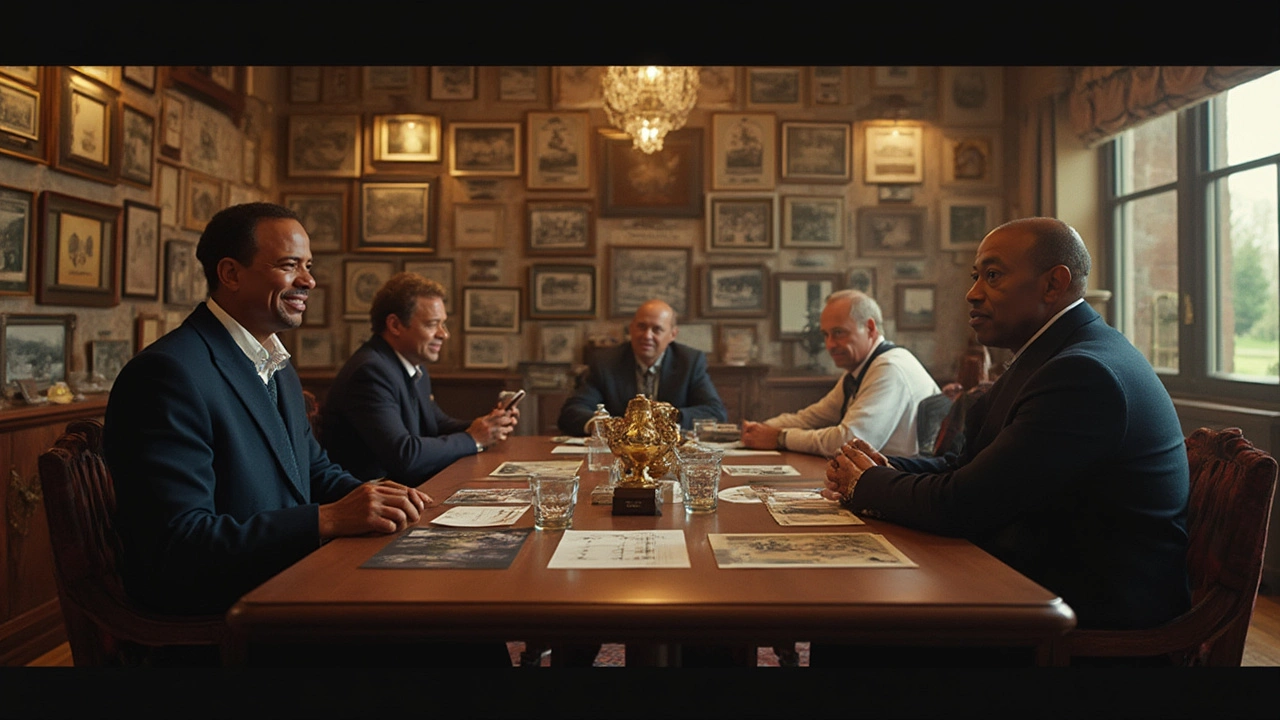
Golf has icons, then it has living blueprints—names that reshape not just history, but the fairways themselves. Tiger Woods isn’t just a name echoing through leaderboards and green jackets; he’s quietly building a new legacy, piecing together courses that reflect his obsession with nuance, challenge, and plain old fun. For decades we watched Tiger destroy records, but these days, he’s building a future under the radar—and his golf course ventures are more interesting than you’d think.
Tiger Woods-Owned Golf Courses: Fact from Fiction
The phrase "Tiger Woods owns golf courses" has a nice ring, but the reality is a bit more complicated—and honestly, more intriguing. Woods isn’t snapping up properties just to slap his name on them. Instead, he’s hands-on, blending ownership with design. There’s only one course in America where Tiger is listed as a full or partial owner: PopStroke. Let’s get this clear: the big, famous 18-hole courses like Bluejack National in Texas or Payne’s Valley in Missouri? Those are Tiger Woods designs, but he doesn't strictly own them. They’re showcases for his architectural artistry, and his company—TGR Design—has been commissioned to shape fairways, bunkers, and greens. Tiny detail, big difference.
So, what does Tiger actually own? PopStroke is a chain of tech-laced, mini-golf-meets-craft-brewery playgrounds. As of 2025, there are locations sprinkled throughout Florida, Texas, Arizona, and one just opened in Nashville. PopStroke isn’t just a tiny golf course in the usual putt-putt sense—it’s a full-on destination, with greens designed by Tiger’s team and a partnership making him a stakeholder and co-owner. While you won’t find sprawling fairways or Tigers lurking in the bushes, you’ll get his hands-on approach, technology-infused putts, and the energy of someone who wants the game more accessible.
Let’s recap. Tiger Woods doesn’t currently own major, 18-hole, traditional golf courses in the way people might dream up. What you see instead is subtle and modern—ownership in a cutting-edge mini-golf chain, and his designer fingerprint on traditional courses owned by resorts or clubs. Fans sometimes confuse "Tiger Woods golf course" with "Tiger Woods-owned golf course." The truth: he’s a partner in business models that include full or partial ownership of entertainment-based golf venues and leads the charge as head designer for high-profile courses you’ve probably seen on TV.
Curious what drives Tiger in this next phase? He’s not just obsessed with competition and ball-striking; he’s always been in love with the details that make a round memorable—the sightlines, the way a bunker slopes, the greens that break left when you expect right. This same mindset bleeds into the properties he touches. PopStroke is a result of his curiosity to bring golf to more people, not just the elite country club crowd.

Inside Tiger Woods’ Most Famous Course Designs
If you’re after the epic bucket-list destinations with Tiger’s DNA in the turf, you’ve got more than a few choices—even if you can’t technically call them his “property.” Bluejack National, carved about an hour north of Houston in Montgomery, Texas, opened in 2016 and turned heads instantly. This was the first Tiger Woods-designed course in the U.S., and players rave about it not because it’s punishing, but because it’s fun. Fairways are generous for average players; the challenge ramps up only as you get close to the green. That’s no accident—Tiger’s been open how he hates the modern trend of impossible courses that suck the joy out of golf for mortals.
Over in Missouri, Payne’s Valley at Big Cedar Lodge gave Tiger the chance to blend modern drama with tribute. This 18-hole public course boldly commemorates Payne Stewart and offers some of the wildest visuals you’ll find in the Ozarks. The highlight? A 19th “bonus” hole, so jaw-dropping you almost forget it’s real. Tiger insisted on making the course walkable and approachable—another move to open the experience up, not lock it away for VIPs. You don’t need to be a scratch golfer to enjoy the course, but you do need curiosity and a sense of adventure.
There’s also El Cardonal at Diamante in Los Cabos, Mexico. This was Tiger’s first course design ever, opening in 2014, and it shows how much he values playability. Instead of relentless water carries and tiny landing areas, El Cardonal teases you with wide fairways but punishes the careless with risk-reward options. It’s proof he wants golfers grinning after the round, not groaning.
On the flipside, Woods doesn’t rush to plant his name just anywhere. He’s said no to dozens of projects that didn’t fit with how he wants to impact the game. If you’re looking for evidence of that, check his unhurried involvement with private courses like The Oasis Short Course at Diamante, and various private club projects in Chicago, Florida, and Utah. Each place shows his evolving vision: make courses tough enough for the weekend warriors but fun for families and newcomers.
Even if Tiger doesn’t "own" these courses in a technical sense, his impact is all over them. Golfers are often surprised just how relaxed and open his courses feel compared to many modern tracks where every mis-hit means double bogey or worse. His design philosophy leans on playability, dramatic views, and approachability, not just torture for the sake of scorecards. Little things like wider landing zones, clever angles, and creative greens make his layouts stand out. It’s a refreshing change in an industry known for toughness over friendliness.
Tip for anyone looking to play a Tiger course: book early. Spots go fast, especially at Bluejack National and Payne’s Valley, which both attract serious golfers and vacationers alike. And if you find yourself in Florida or Arizona craving something lighter, PopStroke offers the Tiger Woods touch without the need for a full set of irons—or a dress code.

The Future of Tiger Woods’ Legacy in Course Design and Ownership
Where is Tiger going next? That’s the question on the lips of every golf fan watching this next chapter. Tiger hasn’t shown much interest in traditional big-club ownership; he prefers influence and innovation over collecting assets. The PopStroke experiment—his boldest foray into mainstream golf ownership—looks set to expand. More venues are popping up, blending casual play with technology in the hope of luring in families, groups of friends, and even work gatherings. Tiger’s not done there. He’s currently at work on courses in the Middle East and Asia; word is, he’s obsessed with natural landscapes and has been hands-on from routing to grass selection. As climate and sustainability become buzzwords, Tiger’s design teams keep tweaking approaches to water use and blending courses into their environment—keeping green golf green, in every sense.
Don’t expect him to suddenly become the sole owner of sprawling resorts. Tiger’s too savvy. He knows the grind of course management, dealing with operational headaches, and balancing the numbers. His angle stays at the intersection of art and business—designing standout spots while co-owning innovative playgrounds like PopStroke. This operating style lets him keep freedom, creativity, and brand power without tying himself to the daily grind running a club.
As for pure design, reviews from pros and amateurs alike have been stellar. Folks mention the unique experience and the earnest intention you feel—from tees to greens. Tiger’s tackled criticism about early minimalist style (too easy, some griped), and he’s responded by crafting courses that test every club in the bag without pushing average players out of the fun. The combination of spacious fairways, classic sightlines, and inventive bunkering is now his signature. You won’t find needless water hazards just for the drama, either—something many appreciate.
Looking further ahead, Tiger’s rumored to be interested in urban golf concepts—a possible game-changer for access and fun in cities without much open land. PopStroke was just the start. Friends close to Tiger say he wants to see cheap, quick, community-based golf options everywhere, from LA strip malls to Asian mega-cities. Watch this space: industry insiders expect a flurry of Tiger-backed ventures using both his design acumen and his growing business empire.
So, what should golfers and fans take away from Tiger’s foray into course design and ownership? It’s simple: don’t picture retirement and nostalgia. Tiger Woods is still shaping the game, brick by brick, hole by hole. His drive now lies in making golf more inviting—and yes, more fun. Whether you’re booking a tee time at Payne’s Valley, planning a spring trip to Texas to play Bluejack, or lining up a wild putting match at PopStroke, you’re stepping onto turf that reflects his ideas. No green jackets required—just the willingness to try, miss, laugh, and relive what got us all hooked on golf in the first place.